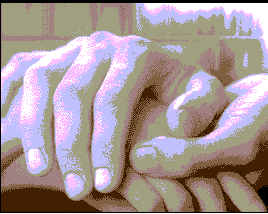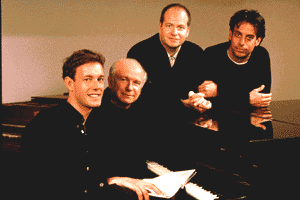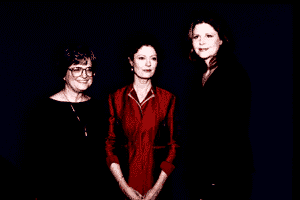
The story of Sister Helen Prejean’s relationship with a murderer on
death row has many elements that make it seem ideal for opera. There is a
loving and emotionally forthright heroine and a grim process of retribution,
both worthy of Bellini or Verdi. The setting, among people who are desperately
impoverished in cash and struggling in spirit, could be that of a verismo
opera. And there is an overwhelming final execution of a man whose
redemption (in the emotional terms of the narrative) is still in the balance.
The triumph of Dead Man Walking, a new opera by Jake Heggie and Terrence
McNally commissioned by the San Francisco Opera, is that the expertise in
other areas of its composer and librettist creates something essentially
new, overwhelmingly moving and powerful within a familiar format.
McNally’s libretto creates coherent scenes and speeches that have the real-life wit and pace of a spoken play but which provide a coherent framework for the music to develop. Sister Helen‘s humour is always present, engaging with that of the people she meets. A mother, presented with a pot-holder her son has made in the nuns’ day-care class, says “I cannot tell you how much I have prayed for this” (a lovely brief characterisation by Donna Volkwijn). The highway patrolman who pulls Sister Helen up for speeding recalls that he gave an IRS man a ticket once and got audited that year (David Okerlund, also very funny, and moving as he asks her to pray for his mother who has cancer). And a warden tells the inmates to “have some respect, there’s a fucking nun on the tier”.
But this is a libretto of scenes and set pieces that give the performers something to work on, not of one-liners. There are difficulties that McNally doesn’t try to overcome but leaves to the music and the performance. Notably, and most difficult of all, he doesn’t try to find language to pin down the character of the murderer Joseph de Rocher, charming and intelligent but guilty of a horrific, brutal crime. Although the themes and some of the scenes are familiar (the ladies have loved a condemned man in his cell since the Beggar’s opera), there is space for the performers to contribute and the audience to respond in ways that are not conventional or predetermined. Most powerfully, the opera begins and all but ends with wordless action, the explicit depiction of de Rocher and his brother murdering a young couple, and his execution by lethal injection, far more controlled but no less horrific in its violence.
Heggie treats the speeches and dialogues as character songs and duets, his
previous preferred forms. This is
convenient,  since the pieces can be easily extracted for auditions and recordings,
but it also ensure that the audience have a sense of what is going on and
where they are within in each scene. Heggie also provides sympathetic,
unobtrusive instrumental music under for the first and last scenes, a
conventional overture and set piece vocal ensembles for focal points. Most
striking of these are Sister Helen‘s first visit inside the prison and
the Pardon Board hearing where the parents of the murdered couple, the
representatives of the legal and prison systems and the Christians all come
together.
since the pieces can be easily extracted for auditions and recordings,
but it also ensure that the audience have a sense of what is going on and
where they are within in each scene. Heggie also provides sympathetic,
unobtrusive instrumental music under for the first and last scenes, a
conventional overture and set piece vocal ensembles for focal points. Most
striking of these are Sister Helen‘s first visit inside the prison and
the Pardon Board hearing where the parents of the murdered couple, the
representatives of the legal and prison systems and the Christians all come
together.
But again, the music doesn’t generally determine the emotion or the narrative. It creates a space full of possibilities in which the audience can respond. The first and last voice we hear is Sister Helen singing, unaccompanied, a spiritual, He will gather us together. The form and words conventionally ask us to join in an act of simple faith, and the opening occurrence seems to do just this, while characterising Sister Helen as a -- non-racist, emotionally generous -- Christian. When she sings the same words and melody at the end, we have seen and perhaps partly understood the pain and difficulty involved in becoming part of a community that includes the whole of humanity, including both murderers and the survivors of those they have murdered.
Other segments are dramatic scenes, close in a way to classical operatic scenas, but with far more space in the music for confusion and uncertainty. The music is a blend of gestures from the blues and spirituals and rhetorically aware atonal word setting, similar to recent Sondheim, though (unobtrusively) more ingratiating melodically, without being trite. The overall effect has elements of Billy Budd, in the male voice ensembles and in the atonal take on romanticism. It also, even more and in many ways, recalls Porgy, where oppressed people express grief and assert their (usually criminalized) resistance in traditional musical forms that take on a new radicalism through the composer’s invention.
Joe Mantello’s direction brought something from Broadway, keeping Michael Yeargan’s impressive set on the move to keep the flow between scenes seamless, but also kept it simple. The most powerful scenes were those where Sister Helen and one other person engaged. Her meetings with Rocher had them sitting in chairs, both facing the audience, perhaps to show the physical and spiritual barrier between them while letting us see them directly. Other encounters, for example, her meeting with the highway patrolman and Sister Rose comforting her when she wakes in the night, were delivered as it were straight to camera without losing the engagement between those involved.
Patrick Summers and the orchestra were, to their credit, almost imperceptible much of the time, keeping the music completely integrated with the performers but bringing clarity to the occasional moments of instrumental complexity.
 The singers, a mixture
of major San Francisco Opera regulars, Merola Program members and less known
singers new to the house, were all outstanding in their commitment and
characterisation. Susan Graham as Sister Helen was a totally captivating
focus, feminine, secure and generous in appearance and voice, delivering
a huge amount of music apparently effortlessly. Frederica von Stade as de
Rocher’s mother was heartbreaking in her appeal to the Pardon Board
for mercy for her son. Amazingly she conveyed numb despair and inarticulacy
through well-made words and music. Theresa Hamm-Smith as Sister Helen’s
best pal, Sister Rose, was vocally impressive and warmly humorous, another
nun to be reckoned with and a singer to watch.
The singers, a mixture
of major San Francisco Opera regulars, Merola Program members and less known
singers new to the house, were all outstanding in their commitment and
characterisation. Susan Graham as Sister Helen was a totally captivating
focus, feminine, secure and generous in appearance and voice, delivering
a huge amount of music apparently effortlessly. Frederica von Stade as de
Rocher’s mother was heartbreaking in her appeal to the Pardon Board
for mercy for her son. Amazingly she conveyed numb despair and inarticulacy
through well-made words and music. Theresa Hamm-Smith as Sister Helen’s
best pal, Sister Rose, was vocally impressive and warmly humorous, another
nun to be reckoned with and a singer to watch.
The parents of the murdered couple, generally presented as an ensemble, were well characterised, full of repressed anger but each an individual. Gary Rideout as Howard Boucher, their spokesman was striking, and slightly disturbing in his controlled anguish. John Ames was engaging as the sympathetic but slightly bumptious prison warden, and Jay Hunter Morris was smugly objectionable as the prison chaplain, the one character whose side of the story isn’t really shown. (Sister Helen Prejean is even handed even about him in the book.)
John Packard was fascinatingly difficult to pin down as Joseph de Rocher, the focus of the drama. In the equivalent role in the movie, Sean Penn had a psychopathic edge but was too cute. Packard has a pleasant light baritone voice and couldn’t convey a physical sense of danger across the space of the War Memorial house. The sense of physical strength conveyed when he did pushups -- while singing, already -- didn’t seem to include the necessary hint of uncontrolled violence. But he looked both mean and vulnerable, and impossible to read, which was right.
Perhaps Packard had an impossible task, since the audience is bound to hope for redemption in the style of Jimmy Cagney. Yet the point of the opera is that faith and hope are never fully gratified. Only love delivers.
H.E. Elsom
 Return to:
Return to: